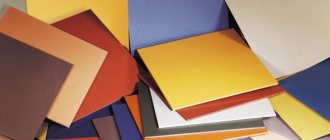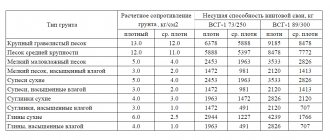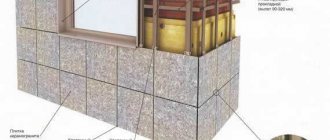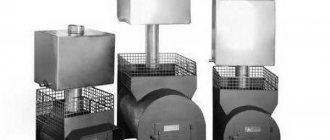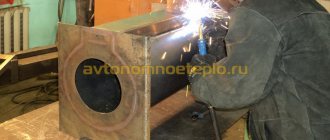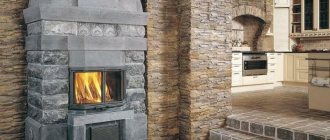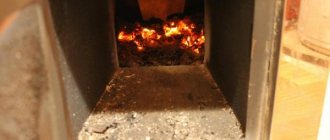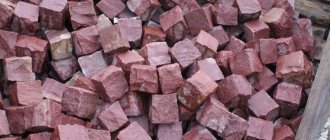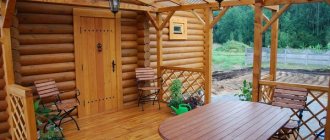In many private houses it is not possible to equip full-fledged heating, so stoves are most often installed. Such an interior object occupies a large area. Therefore, they try to finish it as effectively as possible, so that it not only performs the heating function, but also creates a unique atmosphere of warmth and comfort. Finishing the surface of a stove in a house or bathhouse with decorative stone has become widespread. This modern technology allows you to quickly and without special preparation make a high-quality finish.
Types of facing tiles
Finishing the stove with plaster is gradually becoming a thing of the past, and lining various types of stoves with tiles is becoming increasingly popular. Manufacturers offer various types of facing tiles. They differ in composition, production technology and design ideas.
- Clay based tiles . The most common type. It includes classic tiles, durable fireclay, exquisite terracotta and other types of tiles.
- Tiles based on natural stone . Marble tiles take pride of place in this category. Even the most severe critic will appreciate the marble-lined stove.
- Tiles based on artificial stone . The main component of the sample is cement. On its basis, with the help of various additives, a durable facing material is formed.
Variety of cladding Source kamin-spb.ru
When determining the type of tile for finishing a stove, it is necessary to consider the requirements for it. Let's take a closer look.
Decorative rock
Stone is rarely used for lining a Russian stove; it does not really match the appearance of the structure. Most often, stone is used to decorate the portal or base of the stove, but it can also be used for the entire body.
Materials and tools
For finishing you need:
- facing stone (you can use hewn and wild stone, pebbles);
- adhesive solution (clay or cement);
- level;
- comb;
- rubber hammer;
- solution container;
- metal grid;
- mesh fasteners;
- construction mixer.
The optimal solution for stone is clay in a ratio of 1:2 (clay and sifted sand, respectively). For large-format stones, it is better to take a cement mortar with a component ratio of 1:2:1 (cement, fatty clay, sand, respectively).
Instructions
Scheme
- Before cladding begins, the surface is reinforced with a metal mesh, which is attached to the seams of the brickwork. Next, the mesh is covered with a layer of plaster mortar (as for conventional plastering of a stove). The surface must dry, after which it should be leveled and sanded.
- The cladding begins from the bottom row, the glue is applied with a comb to the surface of the stove and the tiles, then each element is pressed tightly against the wall. Using a rubber hammer, carefully tap the stone to give it the desired position. When laying, it is not recommended to make very wide seams, as the surface will not look very beautiful.
If necessary, individual stone plates are trimmed with a grinder; this should be done as the finishing is being glued. All excess solution is removed immediately, since after drying it will be almost impossible to remove it.
Requirements for facing materials
The facing tiles for the stove will be used in difficult temperature conditions, so the following requirements must be met:
- Naturalness . The tiles should not contain toxic substances; as a rule, when heated, they are released into the environment, which is unacceptable from an environmental point of view.
- Fire resistance . The material must work at temperatures up to 10000C.
- Good thermal conductivity . The material should not interfere with the heating of the room, but prolong it.
- Moisture resistance . With low water resistance of the tiles, the oven may become damp.
- Durability . The thickness of the sample is assumed to be at least 6-8 cm.
- Attractiveness . The appearance of the lined stove should match the interior, be attractive and elegant.
Attractiveness of cladding Source tulikivi72.ru
Properties of decorative stone
The advantages of decorative stone include:
- Durability and reliability. Due to its strength characteristics, artificial stone is very resistant to mechanical and physical damage.
- Easy to care for. The surface of the coating is easy to wash and clean.
- Moisture resistance. A protective layer on the surface of the decorative stone protects the coating from moisture absorption. Therefore, you can safely wash it with a damp cloth and a mild detergent.
- High temperature resistance and fire resistance. Artificial stone will withstand even prolonged exposure to open fire, since it does not burn at all.
- Wear resistance. Despite constant wet maintenance, the stone finishing of the stove retains its decorative properties for a long time without losing its appearance.
- Resistant to sudden temperature changes. Such a material retains its properties despite changes from very low to high values, and vice versa.
- And the biggest advantage is the ease of laying decorative stone with minimal expenditure of time and materials.
Types of facing tiles
Today, on the construction market, tiles for stoves and fireplaces are presented in a wide range. Choosing the best one is not at all easy, but by studying the main options used in cladding, you can understand what is right for you.
Fireclay tiles
The most worthy option for cladding. It is made on the basis of refractory clay interspersed with stone flour, which significantly increases the strength of the sample.
Significant advantages include:
- Maximum fire resistance and heat resistance.
- Resistance to low and high temperatures.
- Neutrality to any aggressive environment.
- High strength.
- Excellent load resistance (due to composition and significant thickness).
- Does not rub, does not slip, does not crack.
- Durability. From experience, fireclay tiles are laid once and for all.
The severity of fireclay tiles Source strojdvor.ru
Cladding with fireclay sample in a combined version Source feeder.kiev.ua
Disadvantages: high cost of the material and little variety in the design of the tiles.
Terracotta
Terracotta is a relatively inexpensive cladding option with a wide range of artistic designs. Terracotta tiles are known for their rough surface and are an imitation of natural stones or brickwork.
Made from kaolin dense, pre-compressed clays. The firing temperature is above 10000C. Terracotta tiles for the stove have a natural surface, but can also be presented with a glazed decorative glossy layer.
Significant advantages include:
- Durability, mechanical strength.
- Stability at different temperatures.
- Fire resistance, high thermal conductivity and excellent heat transfer performance.
Nice terracotta Source postila.ru
Disadvantages: low strength under mechanical stress, and if the cladding is often subjected to mechanical and dynamic loads, it will begin to crumble.
Majolica
It is considered an improved version of glazed terracotta. Made from refractory clay characterized by high porosity. Majolica has its own characteristics, thanks to which it is easy to recognize:
- The shapes are smooth, the edges are rounded.
- It is decorated with white glazed paint, onto which a design is applied manually. Shiny surface.
- Floral motifs in the ornament.
- The predominance of green-blue and brown-yellow shades.
Exquisite majolica Source kamin-keramik.ru
The cladding has all the characteristics of heat resistance. The disadvantage is that it is expensive, but decorating the stove with majolica is worth the money.
Metlach
An interesting option for oven cladding. Metlakh fire-resistant tiles are folded into intricate mosaics, creating unique patterns in the interior. The sizes are small. Brooms are not difficult to stack. It is not demanding in operation.
Distinctive features of the broom:
- not covered with glaze;
- heterogeneous in color scheme;
- manufactured under high-temperature firing conditions (maximum heat resistance);
- durable (comparable to porcelain stoneware).
Amazing broom Source iz-kirpicha.su
Recommends itself well in places with high humidity and works in conditions of maximum temperatures.
Tiles
Tiled tiles for cladding stoves and fireplaces will be the ideal solution. A distinctive feature of the tiles is its unusual geometric shape. Along the perimeter, the tile has “sides”, thanks to which its shape resembles an open box.
Fact! By using tiles in the cladding, the efficiency of the stove can be increased by 10-15%; the heat-saving qualities of this material are very high!
Tiles are durable and environmentally friendly. The choice of colors is very wide. The design is applied by hand, so the products are very expensive. There are dimensional errors, so installation may be difficult.
Stove decorated with tiles Source stroyland.biz
Clinker tiles
An ideal option for cladding fireplaces in a matte version, although products can also have a glazed front side. It is made by mixing several types of clay with the addition of special mineral dyes to give color.
Clear advantages include:
- durability (does not crack);
- color fastness (does not fade, does not fade, does not fade);
- good density indicator (in comparison with terracotta and its varieties);
- resistance to temperature differences.
Unusual clinker Source rusolymp.ru
Clinker tiles for a fireplace are good, but have the disadvantage of lack of calibration during manufacturing, so an error in the size of the samples can create difficulties in installation.
Marble tiles
Marble is good for its majestic ornamentation and chic finish. Stoves are rarely lined with this material, but marble tiles on fireplaces are not the last place in the choice of cladding.
The advantages of marble are determined by durability, color and texture fastness, environmental friendliness and aesthetics. Disadvantages: high cost of products.
Furnace in marble Source mramoroff.com
See also: Catalog of companies that specialize in the design and installation of fireplaces and stoves.
Luxurious marble fireplace decoration Source 2gis.com
Faience
Earthenware is made by dry pressing several types of refractory clays with an admixture of quartz sand. Much stronger than, for example, majolica, so you can use thinner tiles, only 4-5 mm thick, for cladding.
The material is inexpensive. Aesthetically, it is classic faience: white tiles with blue ornaments, no worse than expensive tiles or broomsticks.
Lightness of earthenware Source msk-kamin.ru
Tile
The product has good heat resistance, but the tile is very sensitive to temperature changes.
Fact! If the room is constantly kept warm, finishing the stove with tiles will be an excellent cladding option.
When freezing (no firebox in winter), the tiles will peel off and the glazed surface will crack. The strength is low, the service life is short.
The advantages include ease of care, variety in color and inexpensive cost of products.
Classic tiles in the stove lining Source kitchenremont.ru
Porcelain tiles
It is characterized by a practically zero coefficient of water absorption, due to the monolithic structure. It is produced by mixing several types of clay with quartz sand and marble chips. The coloring is created by adding salts of various metals.
This is interesting! Porcelain tiles are often represented by imitation of marble, granite tiles and even majolica, that is, for a relatively low cost you can line the stove with imitation in expensive shapes and colors.
The advantages include high heat resistance, resistance and durability. Strength is ensured by a tile thickness of 9-12 mm.
Brutal porcelain tile Source yandex.net
Fake diamond
The product made from cement mortars is presented as an imitation of various types of stones, bricks, and other types of finishing. Tinted with various pigments.
The stone is durable and not difficult to use. In terms of technical characteristics, it fully corresponds to natural stone.
An interesting solution - artificial stone Source yandex.net
About tiles
The tiled stove is a truly luxurious structure, even if it is dilapidated, see fig. However, tiling is definitely not the kind of work that can be done by studying the technology from the descriptions; This is an even more delicate matter, requiring experience and accuracy than cladding with natural stone.
Tiled stoves and fireplaces
Tiles are generally prepared from the same kaolin mass as high-quality tiles. To harmonize with TKR and improve the heating technology of the furnace, the tiles are molded into box-shaped ones with a cavity - a tiller, pos. 1a next rice. – which is filled with sand during the cladding process. You need mountain sand with rough grains and a minimal admixture of clay; it does not swell, does not sinter or cake due to cyclic heating. The tiles are placed on a greasy clay mortar; The clay used is white, the sand is the same mountain sand. Add half a glass to a glass of table salt to a bucket of the prepared solution.
Cladding the stove with tiles
Before facing, the tiles are laid out and sorted out, as in the case of wild stone, achieving evenness in the rows. The dimensions of the tiles have been standardized by GOST since 1947, but the tolerance is quite wide, approx. 1.5 mm. It is impossible to achieve less due to the properties of the material itself. With a cladding height of 10 rows, the spacing of the seams can reach 15 mm, which, as you understand, is in no way acceptable.
Note: the base of large artistic panels on tiles is laid out and adjusted by hand at the factory. Therefore, tiled panels are very expensive, but they are put in place without layout.
The tiling is done in order, tying the tiles together with steel pins and wire. As a rule, the stove is lined with tiles in the order of its construction, and the lining must always be ahead of the masonry, as shown in pos. 3. In this case, the tiles are knitted with anchor loops, as in pos. 1b. Some craftsmen (qualitatively few) know how to tile walk-in stoves; in this case, knitting is done with anchor pins, pos. 2.
Tips for choosing cladding
Today, finishing a stove with tiles in a private home is not a luxury. A stove, as an element of the interior, having a special function of heat, can become a real decoration of the room. The choice of cladding is huge; when choosing, you should focus on the following:
- Budget . You can line a stove, for example, with terracotta tiles relatively inexpensively, but when choosing majolica or marble, you need to understand that the price will be many times higher.
- Style . The stove cladding is carried out in the same style as the interior of the room.
- Space . If the area of the room and the ceiling height are small, a large product will look ridiculous, it is worth choosing small-sized ceramic mosaics. On the contrary, a large stove or tall fireplace should be lined with natural stones, marble or porcelain stoneware.
- Quantity : it is worth purchasing with a 10% reserve.
- Tinting . In a calm interior, plain tiles would be appropriate; in a bright and modern interior, chic majolica or tiles would be perfect.
Choosing a strict aesthetic Source cloudfront.net
Tiles and majolica Source puzzleit.ru
The choice of cladding is associated with its technical characteristics specified in the product labeling from the manufacturer.
Marking
Marking allows you to evaluate the quality of the cladding:
- Water absorption coefficient. For finishing the stove, no more than 3% is allowed. Designated "E". Granite tiles have the best water resistance of 0.5%.
- Porosity. It is designated “PEI”, followed by numbers from I to V. For stoves, you should choose material marked PEIIV-PEIV.
- Dimensional accuracy. Marked "A" and "B". This stands for computer-aided design of the pattern. The highest accuracy is marked “A”. This product is much easier to install.
- Chemical resistance. Designated “EN122” with letters from A to D. For stoves it is better to choose “A”.
Labeling symbols Source kuhnyamy.ru
- Variety 1st grade is declared by the manufacturer to be of high quality, defects in the batch are up to 5%, 2nd grade allows 5-25% of defects, 3rd grade – more than 25% of defects.
- Environmental standards. The designation “ECO” or “Eurostandard” on the packaging will guarantee the environmental safety of the product.
- Linear dimensions. The optimal dimensions are no higher than 250x250 mm on the sides. The optimal thickness is 6-8 mm.
Design
Classic stove tiling is characterized by the absence of geometric shapes and a deep richness of complex ornaments, made mainly on the basis of plant patterns. Design solutions determine their place in the interiors of premises:
- In a village house, the cladding is supposed to be natural stone.
- The classic interior will be emphasized by porcelain tiles.
- In modern-style rooms, cozy terracotta in a matte finish would be appropriate.
- Interiors in a modern style will flourish with a stove lined with majolica or tile patterns.
Furnace design Source yandex.net
Colors
The color range of cladding is very diverse. It is selected to match the given tone of the entire interior of the room.
- Marble is presented in the most unusual colors: from soft white to strict black.
- Granite in natural colors is less varied. The tiles are gray, brown or black.
- Ceramics are not limited in the choice of colors. The samples delight with a variety of shades and colors: from the most delicate light colors to the most saturated colored and dark tones.
Multicolor in decoration Source repairblog.ru
Combined options
Combined wood and clinker tile finishing
The lining of the fireplace insert is more interesting in a combined version. The combination of stone and wood fireplace trim gives an original decorative look to the living room. Finishing with modern materials can be interspersed with marble or natural stones, combined with wooden elements and stone, thermal tiles and plasterboard.
Wood finishing seems undesirable from the point of view of fire safety, but processing with non-combustible materials makes the wood resistant to heat. It is advisable to use it for framing a fireplace portal and making a mantelpiece. It is advisable to use heat-resistant species - alder or ash.
For combined finishing, the technique of separating the lower and upper zones of the fireplace is used. Heavy materials are laid below, wood and plaster are placed on top. This finish separates the areas of use: stove, place for firewood, fireplace mantel, chimney trim.
https://youtube.com/watch?v=hWIoTbhcLXc
Cladding technology
Furnace cladding can be done in two ways: with glue or with metal profiles without glue. Before cladding, it is necessary to carry out comprehensive preparation.
How to prepare for cladding
Before tiling the stove, you must:
- Clean the stove from plaster. To facilitate the process, you can use a spray bottle. Once the surface is wet, removing the plaster with a spatula is not difficult.
- Remove remaining particles with a brush. To do this, re-wet the surface of the oven, then clean it. The seams are deepened. Cleaning is done with hand tools, or you can use a grinding machine.
Cleaning with a grinder Source rems-info.ru
Cleaning by hand and with a drill with attachments Source gidpokraske.ru
Important! If you plan to line a new stove, then after finishing the masonry you need to wait six months for the stove to settle!
- Prime the surface of the oven. This will ensure adhesion and additional protection. It is advisable to prime two layers. Before applying the second coat, you need to make sure that the first coat of primer is dry.
Wall priming Source vse-otoplenie.ru
- Level the surface using a 10 mm thick clay mortar. Differences in the wall are unacceptable. The clay mixture is applied to the surface with a spatula and leveled using the rule. The corners are secured with metal corners.
- Lay the reinforcing mesh, pressing it into the solution before it dries, then leave the walls to dry.
- After drying, apply final priming and leave the oven until completely dry.
With smooth walls, the mesh can be stretched without leveling. Source stroyfora.ru
Applying plaster
Here, any heat-resistant composition is used for basic plastering of walls. The solution is thrown onto the mesh and leveled with spatulas, moving from bottom to top.
There is no need to make layers thicker than a centimeter to avoid cracks. Then you can heat the stove and make sure that this will not further destroy the materials laid under the finishing.
Video description
Watch the video on how to attach the reinforcing mesh to the wall of the stove, if the solution is not applied.
After carrying out a set of preparatory work, you can proceed directly to the installation of the facing tiles.
Cladding with glue
Before starting installation, you must prepare the correct adhesive solution. The main components are PVA glue and cement compounds. You can add salt. The main thing is to maintain the proportions correctly.
For a person who does not have experience in preparing the solution, preparing the glue can be quite a difficult task. There is another option - buying a ready-made adhesive solution at a hardware store.
Ready-made glue Source stroyfora.ru
Classic finishing of the stove in the house with facing tiles begins with cutting the tiles. This is a complex process, but with all the necessary tools, the cutting process can only take a couple of hours.
When the glue is prepared and the tiles are cut, proceed directly to installation:
- Work begins with laying the first row. This is done using a building level and a horizontal marking cord.
- The adhesive is applied to the tiles and leveled using a notched trowel.
- A tile with an adhesive composition is applied to the furnace wall and pressed with force. The first tile must be aligned not only vertically, but also horizontally. Subsequent ones are aligned relative to the first.
Attention! The glue begins to set within 7-10 minutes. The position of the tiles must be adjusted immediately during installation.
Applying cladding to glue Source standart40.ru
Features and benefits of the oven
The main difference between stoves and fireplaces is that they heat the room using the walls of the smoke ducts, while the fireplace heats only using the radiant energy of the fire.
Lime-covered Russian-style stove in a country house
Blue tile stove in the kitchen
The Russian stove in the kitchen interior is used not only for heating, it has additional capabilities:
- Used for preparing all kinds of dishes.
- It is equipped with a bed-bed, which is considered the best place to relax.
- Used for drying various clay crafts.
Design of a stove bench in a country house
The fire operating in the stove is covered by a damper, and the chimney has a complex trajectory - such features determine the level of heat transfer.
The stove, unlike fireplaces, does not warm up so quickly, but having accumulated heat, it uses it gradually and evenly. The massive structure radiates heat from its body. In addition, the design of the furnace includes a blower, which allows you to control the air supply and save fuel.
Stove-fireplace in the interior of a private house
Video description
This video shows the combined lining of the stove with artificial stone
Cladding without glue
The installation method without glue is more labor-intensive, but has advantages over the adhesive method. If it is necessary to replace one or more tiles, there is no need to disassemble the entire surface; it is enough to dismantle the damaged ones and put new ones in their place. The cladding in this case is a “constructor”.
An example of dry cladding Source ytimg.com
With this method, tiles for cladding stoves are installed using a dry method. The design is more durable and heat-intensive. It does not require a large complex of preparatory work: the stages of removing old plaster and cleaning can be eliminated in this case.
- Using a building level and a cord, the future frame is marked. The surface of the oven is lined relative to the width of the tiles with a margin of 2 mm for seams.
- A metal frame is mounted. Aluminum profiles and corners are attached to the anchors. The result is a frame structure.
- The frame is checked by running the tiles along the guides. The element must move freely without difficulty or jumping out of the frame.
- The frame is filled with tiles.
- The structure of vertical corner profiles and corners is secured to the self-tapping screws.
This is what a stove lined with the dry method looks like Source ytimg.com
In conclusion, we note that lining a stove with ceramic tiles will visually ennoble any stove. The lined stove will become a bright element of the interior, continuing to fulfill its main purpose of heating the room.
Marking the base
Where to start? And how to ensure even seams? Marking the walls helps with this. It is necessary to determine the starting points of installation. To do this, use a laser or water level. The latter option is preferable if you have a limited budget. It is in no way inferior to the technological version. Plus, in a small area, using a laser does not have any pronounced advantages.
The following recommendations will help you understand where to start and how to work:
- in most cases you need to start from the corners (at least there should be whole elements in the corners);
- with seamless cladding, it is better to lay the stone from the bottom up, and when laying with subsequent jointing (especially when laying porous slabs), it will be more convenient to go from top to bottom - this way the slabs will not become dirty;
- whole slabs - the most visible places; usually these are the top and corners, but you need to look at the situation;
- Usually the bottom row is left for last - it is more convenient to cover the floor with trimming, rather than adjusting the floor covering to the stove stone.
Based on this, the starting points are determined. After this, either lay the first row along the laser mark, or pull the beacon cord (according to the marks).
Recommendation! When laying from top to bottom, it is advisable to use an adhesive with low fluidity. In this regard, the compositions differ from each other - there are also those that do not allow the tiles to “float”, while maintaining plasticity for half an hour
Briefly about the main thing
There are several types of facing tiles: based on clay, natural or artificial stone. The material must be fireproof, heat-resistant, durable, not absorb moisture, conduct heat well and at the same time have an attractive appearance.
The building materials market offers models for every taste and budget: pretty terracotta and harsh fireclay tiles, amazing majolica and delicate faience, majestic marble and modest tiles, strict porcelain tiles and luxurious brooms.
There are two cladding technologies: glue and metal frame. The choice of tiles is made according to technical characteristics, taking into account markings, design and colors, and cladding technology according to the expected operating conditions.
Ratings 0
cutting
Figure 8. Options for cutting stone and tiles
Stone on a concrete base is cut with a grinder with a diamond wheel. When laying ceramic granite, use a specialized tool - a tile cutter.
When decorating the corners of stone cladding, do not use tiled corners. Instead, they make a bevel - they cut the sidewalls at an angle of 45 degrees. On an industrial scale, electric tile cutters are used for this purpose, but in our case, a grinder is sufficient. If the stone is soft, the process does not require much effort and high qualifications. Cut corners can be effectively joined to each other.
Fire protection of adjacent areas
Lining the firebox with bricks in a bathhouse is good protection against fire
The finishing of a sauna stove, as well as the design of fireplaces and stoves in other rooms with wooden surfaces, necessarily involves the installation of protective structures. Their need is quite obvious: the walls of the stove, especially those made of metal, become very hot, and therefore any contact with a flammable material (and wood, even if impregnated with antipyretics, still remains flammable) can lead to a fire.
To solve this problem, you can use a variety of heat-resistant materials to decorate the walls near the stove. I will briefly describe the most popular products in the table below:
Fastening mineralite with screws with bushings
| Material | Features of use |
| The easiest way to protect wooden walls from fire is to build a false wall made of refractory bricks around the stove in a bathhouse or other room. Building stone tolerates heat well and absorbs heat, therefore, in addition to fire protection, it can also act as an additional heat accumulator. |
| Plasterboard sheets lined with natural stone or porcelain stoneware are also a good solution for preventing fire. Fire-resistant plasterboard itself, of course, cannot resist prolonged exposure to very high temperatures, but together with stone cladding it forms a fairly reliable screen. |
| Non-asbestos material produced by the Finnish company Cembrit Oy. Minerite sheets are attached to the wall with screws, and if the stove is closer than 50 cm to the wall, then using ceramic bushings we create a 3 cm gap between the wood and the mineralite. |
| The polished steel screen protects the wall well primarily due to its reflective ability. Naturally, such a screen is mounted not on the tree itself, but on a substrate made of non-flammable material - basalt wool, asbestos sheet, the already mentioned mineralite, etc. |
Painting like from a cathedral
Our user with the nickname Bilibin was inspired to paint her stove while walking around Red Square.
Bilibin
Before you is a painting of St. Basil's Cathedral!
It’s interesting here that this stove was not whitewashed before painting; the design was applied directly onto the unpainted plaster.
Bilibin
The main thing is to plaster on a plastic mesh so that there are no cracks.
